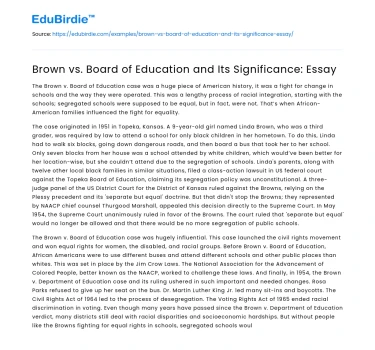The Brown v. Board of Education case was a huge piece of American history, it was a fight for change in schools and the way they were operated. This was a lengthy process of racial integration, starting with the schools; segregated schools were supposed to be equal, but in fact, were not. That’s when African-American families influenced the fight for equality.
The case originated in 1951 in Topeka, Kansas. A 9-year-old girl named Linda Brown, who was a third grader, was required by law to attend a school for only black children in her hometown. To do this, Linda had to walk six blocks, going down dangerous roads, and then board a bus that took her to her school. Only seven blocks from her house was a school attended by white children, which would’ve been better for her location-wise, but she couldn’t attend due to the segregation of schools. Linda's parents, along with twelve other local black families in similar situations, filed a class-action lawsuit in US federal court against the Topeka Board of Education, claiming its segregation policy was unconstitutional. A three-judge panel of the US District Court for the District of Kansas ruled against the Browns, relying on the Plessy precedent and its 'separate but equal' doctrine. But that didn't stop the Browns; they represented by NAACP chief counsel Thurgood Marshall, appealed this decision directly to the Supreme Court. In May 1954, the Supreme Court unanimously ruled in favor of the Browns. The court ruled that 'separate but equal' would no longer be allowed and that there would be no more segregation of public schools.
Save your time!
We can take care of your essay
- Proper editing and formatting
- Free revision, title page, and bibliography
- Flexible prices and money-back guarantee
The Brown v. Board of Education case was hugely influential. This case launched the civil rights movement and won equal rights for women, the disabled, and racial groups. Before Brown v. Board of Education, African Americans were to use different buses and attend different schools and other public places than whites. This was set in place by the Jim Crow Laws. The National Association for the Advancement of Colored People, better known as the NAACP, worked to challenge these laws. And finally, in 1954, the Brown v. Department of Education case and its ruling ushered in such important and needed changes. Rosa Parks refused to give up her seat on the bus. Dr. Martin Luther King Jr. led many sit-ins and boycotts. The Civil Rights Act of 1964 led to the process of desegregation. The Voting Rights Act of 1965 ended racial discrimination in voting. Even though many years have passed since the Brown v. Department of Education verdict, many districts still deal with racial disparities and socioeconomic hardships. But without people like the Browns fighting for equal rights in schools, segregated schools would probably still exist.
Did you like this example?
Make sure you submit a unique essay
Our writers will provide you with an essay sample written from scratch: any topic, any deadline, any instructions.
Cite this paper
-
APA
-
MLA
-
Harvard
-
Vancouver
Brown vs. Board of Education and Its Significance: Essay.
(2024, February 09). Edubirdie. Retrieved December 22, 2024, from https://edubirdie.com/examples/brown-vs-board-of-education-and-its-significance-essay/
“Brown vs. Board of Education and Its Significance: Essay.” Edubirdie, 09 Feb. 2024, edubirdie.com/examples/brown-vs-board-of-education-and-its-significance-essay/
Brown vs. Board of Education and Its Significance: Essay. [online].
Available at: <https://edubirdie.com/examples/brown-vs-board-of-education-and-its-significance-essay/> [Accessed 22 Dec. 2024].
Brown vs. Board of Education and Its Significance: Essay [Internet]. Edubirdie.
2024 Feb 09 [cited 2024 Dec 22].
Available from: https://edubirdie.com/examples/brown-vs-board-of-education-and-its-significance-essay/
copy






 Stuck on your essay?
Stuck on your essay?

